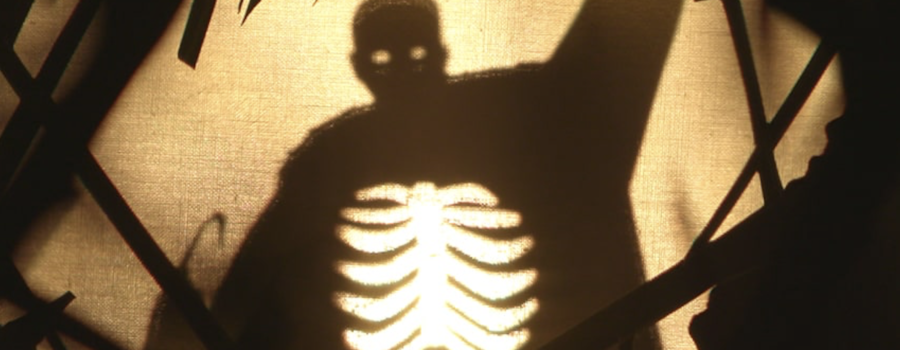Nia DaCosta Digs Deep Within the Annals of Black Art History in Candyman
[Published at Incluvie] Nia DaCosta’s use of Black artists historically speaking out in her spiritual Candyman sequel, brilliantly realized by a small art production company named Manual Cinema, traces back to artists such as John W. Cooper Jr., or the “Black Napoleon of Ventriloquism’s” use of dummies in the 19th and 20th centuries to fight racial violence, and Ralph Chessé, a famous puppeteer who opened his own theater in San Francisco in the early 1920s, operating marionettes. “Candyman ain’t a ‘he.’ Candyman is the whole damn hive,” proclaims William Burke (Colman Domingo) to Brianna (Teyonah Parris). He represents all Black victims of white supremacy, and this art form narratively conveys it in a succinct, adulatory way, the history of which is rare to find. In fact, one of the few ways this type of Black art lives is through the “Living Objects: African American Puppetry” exhibit at Ballard Institute & Museum of Puppetry in Storrs, CT.
Artists play a complex role in DaCosta’s new vision, serving as both a source of division between the projects and the whiter, upper-class high rises a mere few blocks outside of them, and as an important link to Candyman’s past and the generational trauma the persona represents. Candyman is both the ghost of a 19th Century man who fell in love with one of the subjects of his commissioned portraits who was brutally slaughtered for at the hands of white men, as well as every other Black man who faced a similar fate, including, eventually, Anthony McCoy (Yahya Abdul-Mateen II), also an artist, desperate to escape his artistic block, even if it means exploiting his own community.

“I think it’s a really great way to show this Black man trying to navigate a very white world, someone who is also being asked to exploit his community in order to make art.” DaCosta tells the New York Times. “He’s trying to write a thesis, trying to get inspiration for his work and get out of the slump he’s in. Almost all Black artists, no matter what industry they’re in, deal with this.” Like the public housing project, Cabrini-Green, that McCoy bases his latest project on to free himself of the artistic “slump” in which he finds himself, the art world is historically controlled by a white majority. However, Candyman, and everything he represents, won’t let McCoy forget what that truly means.
“It’s all about, ‘My name is to be remembered, My story is to be remembered’ — by this community in particular,” DaCosta further explains to the New York Times. “Because the community doesn’t exist anymore, and gentrification changed the demographics of the community.”
The Projects – White Man’s Creation
Believe it or not, conservatives mobilized against then-President Truman’s initial proposal for additional projects after World War II. Although they proclaimed them too socialistic, they inadvertently attempted to ban housing segregation, which would have prevented so many problems for the Black community in the future.
Paul Douglass, a liberal senator from Illinois famously announced: “I should like to point out to my Negro friends what a large amount of housing they will get under this act… I am ready to appeal to history and to time that it is in the best interests of the Negro race that we carry through the housing program as planned, rather than put in the bill an amendment which will inevitably defeat it.” It was a controversial, manipulative way to ensure votes for the Housing Act and allow city officials and planners to discriminate based on race.
With the Housing Act of 1949 passed, and housing racially segregated across America, many policies enacted by white government officials deteriorated the Black community. In “High-Risers: Cabrini-Green and the Fate of American Public Housing,” which DaCosta referenced in the research phase during Candyman‘s pre-production, author Ben Austen explains that an extremely high demand for housing in the projects eventually pushed working-class families out in favor of poor people who couldn’t afford these units when government officials addressed lowered their income cutoff. The Chicago Housing Authority evicted working-class families, the initial target tenant profile of these housing projects. Austen points out that this policy created by the Authority significantly lowered the marriage rate in the projects, as a joint family income may raise their earnings above the cutoff. Now, the projects were segregated by both race and income. Families in the projects were splintered, and many children grew up without a present father or mother as a result of the Authority’s new policy to accommodate for poorer families. By 1970 — where the legend of Candyman in Cabrini-Green began — the median income of Chicago’s public housing was barely one-third of the city’s average as a whole.

On top of this, the residents initially hired by the city for maintenance — a working-class job — were fired to further accommodate the poor families who initially couldn’t live in the projects, leaving public housing like Cabrini-Green in awful conditions. This backfired on the Authority’s policy, with a high tenant turn-around rate and many units left unoccupied due to unlivable conditions.
The government officials eventually turned their backs on projects like Cabrini-Green, leaving residents to resort to crime to make a living. This prompted an oppressive Chicago Police Department to racially profile tenants and “monitor” the projects with extreme prejudice. This is the backdrop of Candyman, both the original and the remake. This brief history gives one the sense of how much the projects were created — and destroyed — by white people, and adds immense depth to the line in Candyman that “white people created the projects.”
The Sociopolitical Drive Behind Shadow Puppetry as a Narrative Device in Candyman
“We realized that shadow puppetry is good not just for the flashbacks, but codifying the storytelling, the legend.” DaCosta says to the New York Times. “Shadow puppets are much cruder, much more over-the-top. It’s illustrating this isn’t real life and the way we think of real life. This is a story, even though it’s based on real life.” Much like what Cooper did in creating stories of white men perishing with his dolls, often “codifying” real life, DaCosta does in recreating the history of Candyman’s roots. Yes, everything about the police brutality and white supremacy told through the shadow puppetry is based on real life, but the supernatural element is fictional, of course, as are the characters. And DaCosta wanted to visually separate this sequel from the original as much as she could.
As for the art that McCoy paints on-screen in Candyman, DaCosta personally picked Black artists Cameron Spratley, who’s in the process of completing his MFA at the School of the Art Institute of Chicago, and Sherwin Ovid to bring it to vivid life, according to Variety. As Spratley explains, his artwork is “a critique and problematization of the relationship between specific racialized forms of state or cultural violence and their normalization in popular culture writ large.” There’s an even deeper history of Black culture in Spratley’s art in the mural of Candyman‘s third act, from which he took inspiration in Chicago’s Black churches and music: “The center of the mural is inspired by the ‘Black Moses’ album by Isaac Hayes,” he tells Variety.

As with the projects he studies, McCoy’s pretentious Art world is controlled by condescending white people, his manager even coining him the, “Great Black Hope of the Chicago Art World,” while a racist critic, Finley Stephens (Rebecca Spence), refers to his work as stereotypical and cliché. This is an almost ironic nod to bot Spratley’s comment about the normalization of white on Black violence in popular culture, as well as DaCosta’s comment to The Guardian, explaining, “We should be able to make different kinds of movies,” not only ones that, “traffic in Black pain. And I feel like a lot of black film-makers are asked to or expected to do that.” Commenting on the state of white on Black violence, however, is never going to be “stereotypical,” as Stephens so crudely suggests to McCoy. It’s not something fashionable, or something that’s a passing fad. It’s something very real and, sadly, always current. However, when someone like McCoy exploits Cabrini-Green for his own self-interest, thus selling his soul, the reasons behind honoring the Black victims who died in the projects in which he once lived, and the victims who died long before him at the hands of white people, become false. He knows full well and even tells Stephens that artists don’t exploit the projects, white people do. It’s an allegory for the exploitation of Black people, in general.
Black Art History’s Link to Shadow Puppetry
Shadow puppetry, an ancient Southeast Asian tradition, was most recently brought back by the Black artistic troupe, String Theory Theater (Dirk Joseph and his daughters Sequoia and Azaria Joseph) in their 2016 play, “For the Love of Cats and Dogs.” This is what a young Troy (Nathan Stewart-Jarrett’s younger self), uses to entertain himself in Candyman, and what DaCosta chooses for the film’s flashbacks. Similar forms of shadow puppetry in Black art history come from artists such as Cooper and Chessé. Cooper first played with the allegorical exploitation of Black people in art in the form ventriloquism with dummies, using these dolls to talk back to the white majority, putting words in their mouths by voicing their characters. Cooper was initially part of an African American minstrel group named Richards and Pringles Georgia Minstrels, performing for predominantly white audiences. However, Cooper was the only member of the Pringles who didn’t use blackface, eventually incorporating a vaudevillian approach to his act, eliminating singing, and denouncing the minstrel shows while performing, earning his aforementioned nickname, the “Black Napoleon of Ventriloquism.” After that, he formed a solo act named, “Fun in a Barber Shop,” which set a scene of a white barbershop with Black employees. Cooper operated all five dummies, providing each voice as well.
Ralph Chessé, who was forced to suppress his Creole and African American heritage in the midsts of white artists in order to succeed, created one of the most popular children’s programs to date, and the longest running in San Francisco television history, titled, The Wonderful World of Brother Buzz. It featured two characters, Brother Buzz and his pal Mr. Robin Redbreast, who are famous representations of black dandyism, an idea of which the character of Candyman himself has always played with in the form of his fancy, 19th Century European garb. Other similar art forms to shadow puppetry come in the form of jig dolls — wooden dolls with loose limbs for imitating dancing attached to metal rods at the bottom — a traditionally white art form that often uses Black historical figures and characters. Black artists have recently used these to take back agency, such as Garland Farwell in 2017, whose figures, “suggest traditional cultural markers and idioms, from the Buck Dance to Jim Crow” (a period rife with lynchings) according to the “Living Objects” online exhibit.

Many Black historians argue that lynching itself is a form of public performance, something that happens often both in real life and throughout Candyman. In Towards an Aesthetics of the Puppet, author Steve Tillis argues that puppets allow the audience to see them either as inanimate objects or as human beings with agency. This “double vision,” as he refers to it, is entertaining to the viewer. However, both the normalization of Black people on stage in minstrel shows, as well as the numbing lynching violence against Black people in real life that Spratley mentioned, further blurs this line of double vision, muddling the performers creative vision of expressing Black culture and history. To McCoy, Candyman may as well have been an inanimate object. His obsession with him created a form of double vision until he became the work in which he was attempting to represent. DaCosta’s sequel, and the exchanges between McCoy, his manager, and his critic, further exemplify this double vision. When W.E.B. Du Bois wanted theater “for us, by us, about us, and near us,” it was an attempt to exile the white-dominated Art world in which McCoy finds himself.
As “Living Objects” co-curator Paulette Richards explains in her introduction essay to the exhibit: “John Bell notes, in American Puppet Modernism, that object performance differs from acting and dance because “in object performance, performer and spectator are both focused on the object, not on each other.” In this context, the “living object” becomes part of a community that affirms its agency — at least for the duration of the performance. Thus African American object performers can define a character’s voice and image and induce audiences to accept the character as a living agent even though all parties involved know the object is not alive. If audiences can accept the agency of a black puppet, perhaps when they leave the performance space they can more readily recognize the humanity and agency of black people. This is an extension of what DaCosta was articulating when she told the Times that shadow puppets were a form of “codifying the storytelling, the legend,” as many of the puppets depict real-life racial killings of Black people in Candyman. As such, hopefully, the audience, as Richards says, can leave the theater after viewing the film, recognizing the humanity and agency of Black people by accepting the agency of a Black puppet.





Leave a Reply
Your email is safe with us.